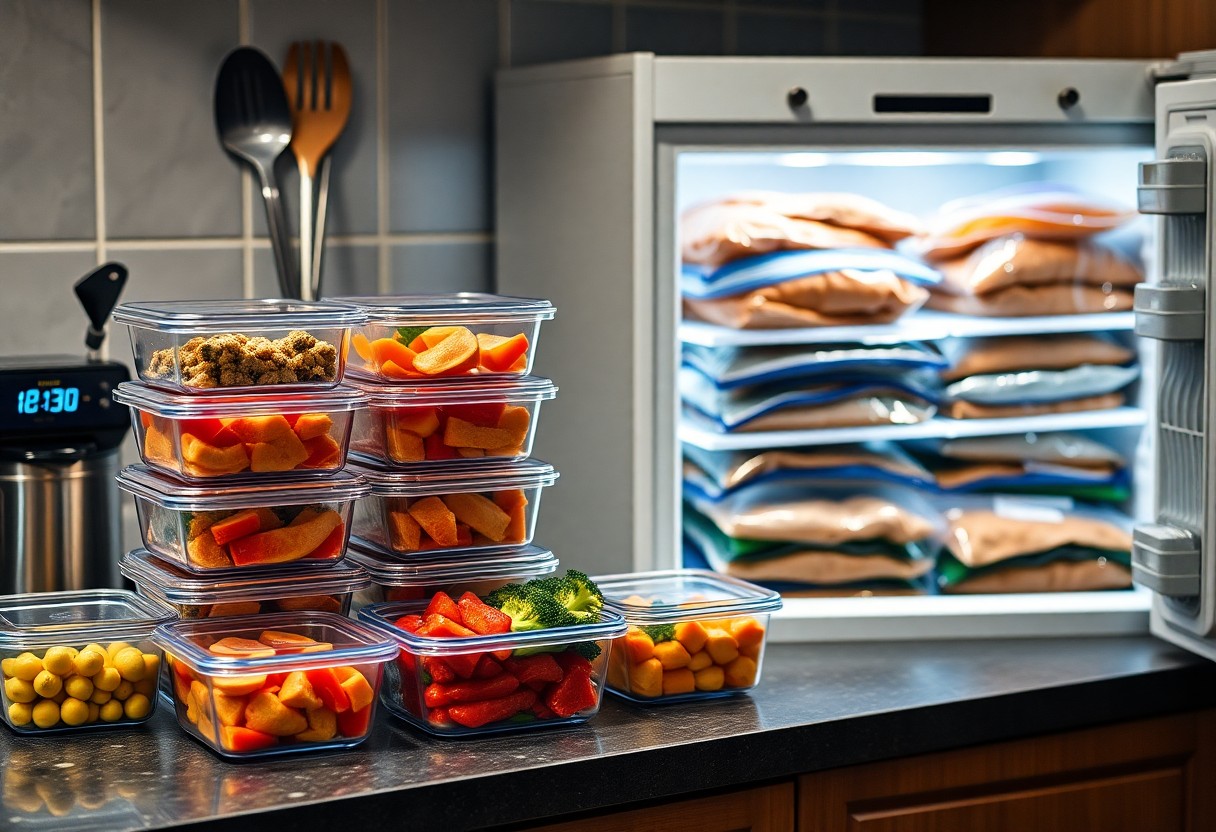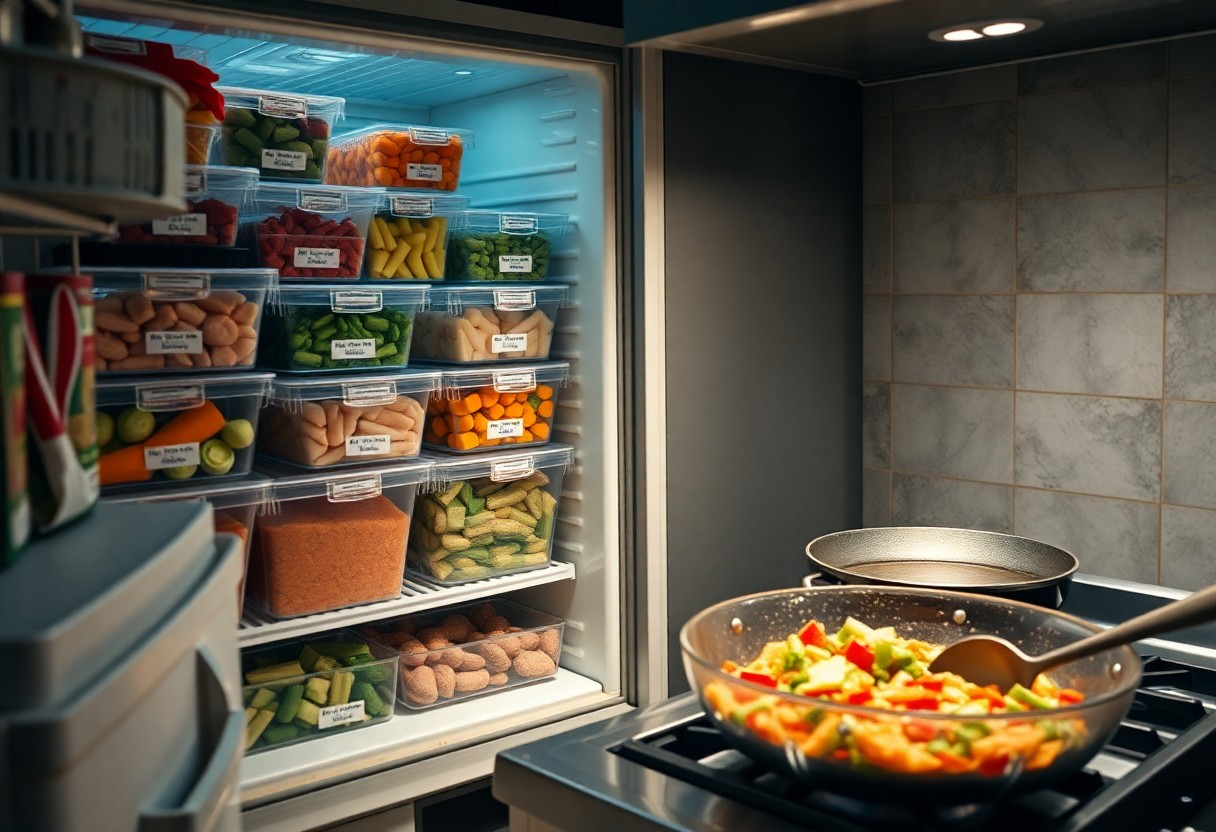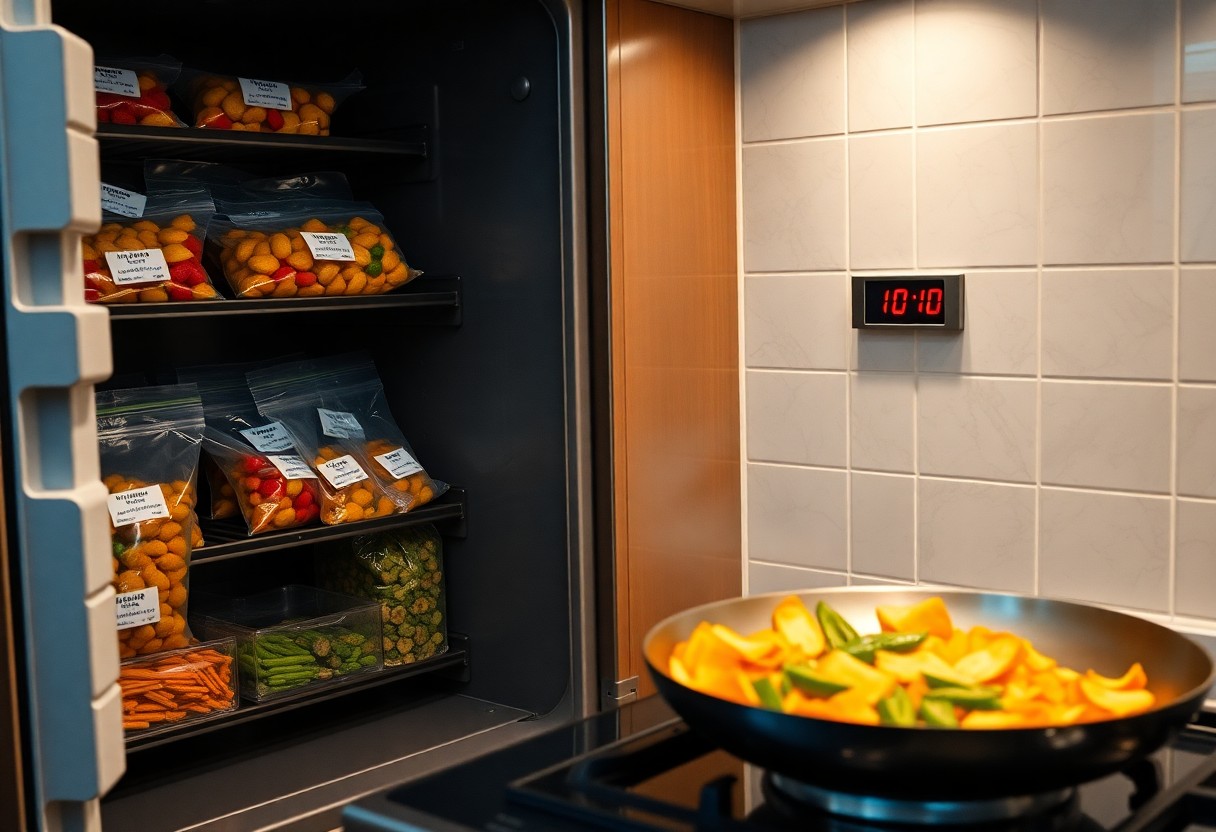Just imagine being able to whip up a delicious meal in a fraction of the time it typically takes. With freezer-to-pan cooking, you can drastically speed up your dinner prep without sacrificing flavor or nutrition. This method enables you to pull ready-made ingredients straight from your freezer, minimizing food waste and allowing you to spend more time enjoying your meal instead of preparing it. You’ll find that harnessing the power of your freezer not only simplifies cooking but can also enhance your culinary flexibility!
Key Takeaways:
- Freezer-to-pan cooking eliminates prep time since meals are already prepped and frozen, allowing for quick transitions from freezer to cooking.
- Frozen ingredients can be cooked directly without thawing, which speeds up meal preparation and reduces the need for extensive planning.
- Having a variety of frozen meals on hand provides convenience, enabling faster options for dinner during busy weeknights compared to the time spent sourcing and prepping fresh ingredients.

The Time-Management Advantage of Freezer Cooking
Freezer cooking not only enhances efficiency but also gives you back valuable time during your busy week. With meals prepared in advance, you bypass the lengthy process of chopping, marinating, and measuring ingredients. Instead, combine this time-saver with a solid strategy, and you’ll find yourself transforming dinner prep into a matter of mere minutes.
Time Savings Compared to Fresh Meal Prep
Time Comparison: Freezer Versus Fresh
| Activity | Time Required |
|---|---|
| Fresh Meal Prep | 60-90 minutes |
| Freezer Meal Preparation | 30-45 minutes |
Quick Thawing Techniques That Maximize Efficiency
Utilize several quick thawing methods to ensure that your frozen meals can go from the freezer to the pan in record time. For instance, submerging vacuum-sealed bags in cold water can thaw meals within an hour. If you’re in a rush, using the microwave’s defrost setting is effective, too, as long as you keep a close eye to avoid partial cooking.
By mastering these quick thawing techniques, you can significantly reduce waiting times and keep the dinner vibe spontaneous. If you opt for cold water immersion, it’s not only fast but also safer than leaving meals on the counter. For microwave thawing, make sure to stir or flip the meal halfway through to guarantee even thawing. These strategies smoothly position you to have family dinners ready in less than an hour, giving you back precious time without sacrificing quality or flavor.
The Science of Flavor Preservation
Understanding how flavors are preserved during freezing can enhance your cooking experience and refute misconceptions about frozen foods. Fresh ingredients do have their charm, but freezing plays a significant role in maintaining flavor integrity. This process effectively halts spoilage and keeps flavors locked in, enabling you to enjoy the taste of ripe, seasonal produce any time of the year.
How Freezing Locks in Freshness
Freezing works by rapidly lowering the temperature of your food, which inhibits enzyme activity and slows down microbial growth. This immediate chilling process preserves the texture, color, and nutrient content of your ingredients, ensuring that they taste as vibrant as they did when first harvested. Using methods such as blanching before freezing can further enhance this effect, allowing you to capture every essence of freshness.
Flavor Development During Frozen Storage
While the freezing process retains freshness, it can also contribute to flavor development over time. As frozen foods sit in your freezer, their cells slowly break down, creating a release of flavors that can meld beautifully, enriching the overall taste of your meals. This means that well-prepared frozen meals can yield even deeper and more complex flavors when cooked.
In the frozen state, biochemical reactions continue at a much slower rate, leading to unique developments in flavor profiles. For example, vegetables like peas and corn can develop a sweeter taste as they freeze, altering their flavor and making them ideal for soups or stir-fries. A study from the Institute of Food Technologists found that frozen fruits can often retain 80-90% of their original nutrients, while enhancing sweetness and depth, making them a perfect addition to smoothies and desserts. When you choose high-quality frozen ingredients, you’re not just preserving convenience; you’re also tapping into an evolving palette of flavors waiting to be enjoyed in your next meal.
The Economics of Stocking the Freezer
Stocking your freezer can significantly impact your grocery budget and meal planning efficiency. By purchasing meats, vegetables, and grains in bulk, you often benefit from lower prices per unit. This strategy allows you to take advantage of sales and seasonal produce, ensuring you make purchases that extend your dollar further while providing an array of meal options at your fingertips. Thus, maximizing the use of your freezer can lead to long-term savings and less frequent shopping trips, enhancing both your culinary and financial outcomes.
Budget-Friendly Benefits of Bulk Cooking
Bulk cooking saves money by reducing meal costs and minimizing impulse purchases. When you prepare large quantities, you’re less likely to end up with waste, as your meals are prepped and portioned. Additionally, utilizing bulk ingredients means you pay less per serving, making it a smart, economical choice that allows you to indulge in a variety of flavors without breaking the bank.
Reducing Food Waste Through Freezer Management
Effective freezer management plays a vital role in reducing food waste, allowing you to maximize your grocery investments. By properly storing food and organizing your freezer, you can keep track of items nearing expiration and ensure they are used before spoilage. This proactive approach not only conserves food but also saves you money over time by minimizing unnecessary expenditures on groceries that go uneaten.
One strategy to improve freezer management involves labeling and dating all items before placing them inside. This practice ensures that you know exactly what you have and its freshness, which reduces the chances of food being forgotten and ultimately thrown away. When you make use of your frozen staples, you can create meals without the stress of having to use fresh ingredients that might spoil soon. In doing so, you contribute to both your wallet and the environment, as less food waste means a smaller carbon footprint. Keeping a running inventory can further enhance this process, allowing you to prioritize what to cook based on what you have stored, ensuring nothing goes uneaten.

Simplifying Meal Planning with Frozen Ingredients
Using frozen ingredients transforms meal planning into a streamlined process. With your favorite ingredients at the ready, you can easily curate a week’s worth of meals without the stress. By keeping a variety of proteins, vegetables, and grains on hand, you can quickly concoct dishes that cater to your cravings, all while eliminating the need for last-minute grocery runs.
Creating Versatile Meal Bases
Starting with a versatile meal base makes meal assembly quick and efficient. Think of staples like cooked quinoa, stir-fried vegetables, or pasta, which can be frozen and later combined with different sauces or proteins. This flexibility allows you to create numerous meals from just a few foundational components, providing both variety and convenience.
Building a Flexible Freezer Inventory
Establishing a diverse and flexible freezer inventory is important for efficient cooking. Stock your freezer with a rotating selection of proteins such as chicken, beef, and shrimp, alongside seasonal vegetables and grains. This variety not only enhances meal creativity but also cuts down on the time spent deciding what’s for dinner. When you have a well-stocked freezer, meal prep becomes as simple as grabbing a few items, tossing them in a skillet, and cooking up deliciousness in no time.
A flexible freezer inventory encourages experimentation and reduces food waste. When purchasing produce in bulk, flash freeze surplus quantities to preserve freshness, ensuring you always have them on hand. Organize your freezer with clear labels and a quick reference list, so you can easily spot ingredients you have. This method turns your frozen food into a treasure trove of possibilities, sparking inspiration for new meals and adapting to changing cravings. Explore new recipes and flavor combinations by utilizing what you already own, making dinner exciting and reducing grocery expenses.
The Psychological Edge: Stress Reduction in Cooking
Cooking can often feel overwhelming, especially after a long day. By shifting to freezer-to-pan meals, you dramatically reduce the mental strain associated with daily meal prep. Knowing that a delicious, homemade meal is just minutes away allows you to focus on enjoying cooking rather than feeling pressured by time constraints or ingredient shortages. This approach not only saves time but also clears your mind, making meal preparation a much more enjoyable experience.
Alleviating Decision Fatigue with Prepped Meals
Having prepped meals ready to go helps you escape the trap of decision fatigue. You eliminate the daily dilemma of “what’s for dinner,” allowing you to focus on other priorities. Instead of scanning the pantry or searching through recipes, you simply grab a frozen meal and follow a few simple reheating steps. This efficiency saves energy and mental bandwidth for more important decisions throughout your day.
The Confidence Boost from Having a Well-Stocked Freezer
A well-stocked freezer creates a sense of security and confidence in your cooking abilities. When you have a variety of pre-prepped meals readily available, you can tackle dinner without anxiety. You’re equipped with options, whether it’s a comforting casserole or a zesty stir fry, and this flexibility allows you to adapt your meals based on cravings or dietary needs. Knowing that you can whip up a nutritious, flavorful dish in no time not only saves you from last-minute takeout but also builds your culinary skills over time.
This confidence stems from having a diverse selection of ingredients and meals just a few steps away. It invites creativity while cooking, enabling you to experiment without the pressure of starting from scratch. The reassurance that a delicious meal is within arm’s reach empowers you in the kitchen, transforming what was once a stressful chore into an inspiring culinary adventure. With each meal prepared and enjoyed, you can relish the sense of accomplishment that comes from mastering freezer-to-pan cooking.
Summing up
With these considerations, you can see how freezer-to-pan cooking can surpass fresh ingredients in terms of speed. By having ready-to-cook meals at your fingertips, you eliminate prep time and reduce decision fatigue, allowing you to get dinner on the table quickly. This method not only saves time but also ensures that you have flavorful, nutritious meals available, even on your busiest days. Embracing freezer-to-pan cooking can streamline your weeknight dinners, making healthy eating convenient and efficient.
Q: What are the main benefits of freezer-to-pan cooking over fresh cooking in terms of speed?
A: Freezer-to-pan cooking offers several advantages that can significantly reduce meal preparation time. First, many freezer meals are pre-prepped, meaning the vegetables are chopped, proteins are marinated, and spices are mixed before freezing. This eliminates the time needed for these steps when you are ready to cook. Additionally, cooking from frozen often requires less attention; once the meal is on the heat, there’s usually no need for constant monitoring, allowing you to multitask during the cooking process. Finally, many freezer meals are designed for quick cooking methods, such as stir-frying or one-pan meals, which further accelerates the process.
Q: Are there any downsides to using frozen ingredients compared to fresh ingredients in terms of speed?
A: While freezer-to-pan cooking is typically faster, there are a few points to consider. Some freezer meals might require a longer cooking time if they weren’t specifically designed for quick preparation. Additionally, certain textures and flavors might differ from fresh ingredients, although many recipes mitigate these differences effectively. Lastly, for those prepared meals that need thawing before cooking, it’s important to plan ahead, as this might add extra time if the meal isn’t transferred from the freezer in advance.
Q: How can I effectively plan my meals to maximize the speed benefits of freezer-to-pan cooking?
A: To optimize meal preparation speed, planning is key. Start by organizing a freezer inventory to know exactly what meals are available. Aim to batch-cook several meals at once, ensuring that you are utilizing your time efficiently. Label all meals with cooking instructions and dates to avoid confusion later. During busy weeks, simply pull out a meal from the freezer the night before to allow it to thaw in the refrigerator, or choose meals that can go straight from freezer to pan without thawing. Additionally, keeping a variety of quick freezer meals on hand, such as stir-fries or casseroles, will ensure that you always have fast options available for any night of the week.
